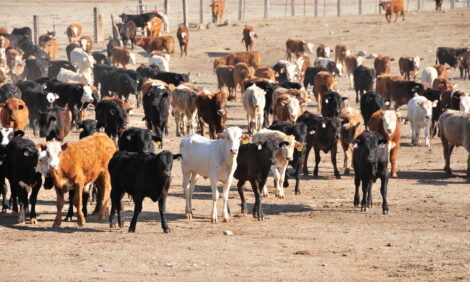



CME: Currency Exchange Rates - How They can Affect Meat Supplies and Prices
US - Equity markets have been particularly volatile in recent days as market participants try to weigh the effect of weak growth in EU and China with the likelihood that the US Federal Reserve will keep rates low for much of 2015, write Steve Meyer and Len Steine.We will not go into this whole discussion here, one can open the latest Wall Street Journal for that.
But in this context we wanted to focus on one aspect - currency exchange rates - and how that can affect meat supplies and prices for the next few months. Since July, the US dollar has posted some significant gains vs. most currencies.
The chart to the right shows performance vs. the currencies of countries that are big buyers or sellers of meat to the US (Australia, Japan, Canada, Mexico) or countries/ regions that compete with US in global markets (Brazil, EU).
In terms of competition in the global marketplace, the US has lost significant ground to both Brazil and the EU. The US dollar was up as much as 14 per cent vs the Brazilian Real but currently is up about 9 per cent since July.
Compared to the Euro, the US dollar is currently about seven per cent more expensive than in July and we have seen similar gains vs. the Australian Dollar and Japanese Yen. But what does this currency move mean in terms of US trade? First, a strong US dollar tends to support US beef imports as it effectively lowers the price of goods in other markets.
As you can see from the table to the right, beef represents by far the largest tonnage of meat protein imported by the US. Indeed, the US is one of the largest beef buyers in the world. So far this year, US beef imports have been about 1.873 billion pounds (carcass wt. equiv), 294 million pounds (+18.6 per cent) larger than a year ago. Australia alone has accounted for almost 200 million pounds of the increase.
Keep in mind that this data is through August and there is a significant amount of beef that Australia shipped since then. Australian beef exports to the US in September were 142 per cent larger than a year ago and the largest monthly volume on record.
Record US lean grinding beef prices were further amplified by the strong US dollar and encouraged Australian packers to try and ship as much beef as they could to the US. We effectively were able to outbid many other buyers to secure the additional supply.
The strong US dollar and record prices paid for pork in the US also allowed US importers to increase pork imports by 44 million pounds (+7.8 per cent), with the bulk of that increase from Denmark and Poland. As for chicken and turkey, US imports are minimal as domestic supplies are abundant and much more competitive relative to other markets.
Despite all the talk of COOL and other protectionist moves, the reality is that exports are critical for the US meat protein industry.
Combined US beef, pork, chicken and turkey import volume in the first eight months of this year was 10.494 billion pounds compared to 2.584 billion pounds of meat imports. With a four fold advantage, one can understand the importance of the currency valuations.
Since July, the appreciation in the value of the US dollar has made beef, pork and poultry five-seven per cent more expensive and this on top of the price appreciation we have seen in US domestic terms.
It is a measure of extremely strong demand that export volumes have been able to sustain the same levels as a year ago. The weekly beef export data, which we need to take with some caution, showed that beef shipments to Japan in in the last four weeks are up some 42 per cent compared to a year ago while exports to Hong Kong were up five per cent.
Overall US beef exports in the last four weeks are up two per cent even with the strong US currency. We think this helps explain some of the rally in cattle futures. As for pork, the weekly data is improving but we still cannot use it to run year/year comparisons.
In any given day, many things impact trading in livestock markets. But over time prices reflect broad fundamental trends and the currency exchange rate environment is one of them.
TheCattleSite News Desk


